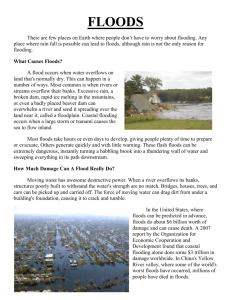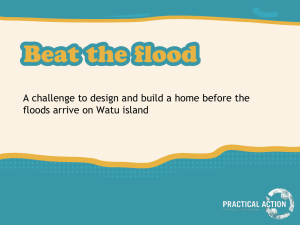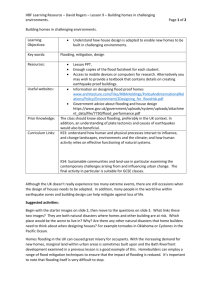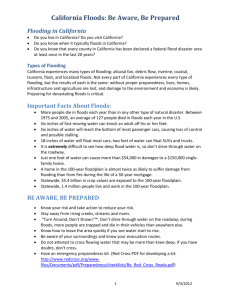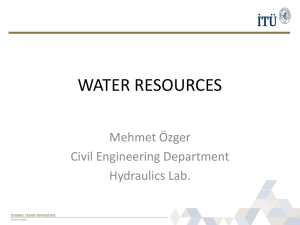WEATHER & CLIMATE Case Study SUMMARY
advertisement
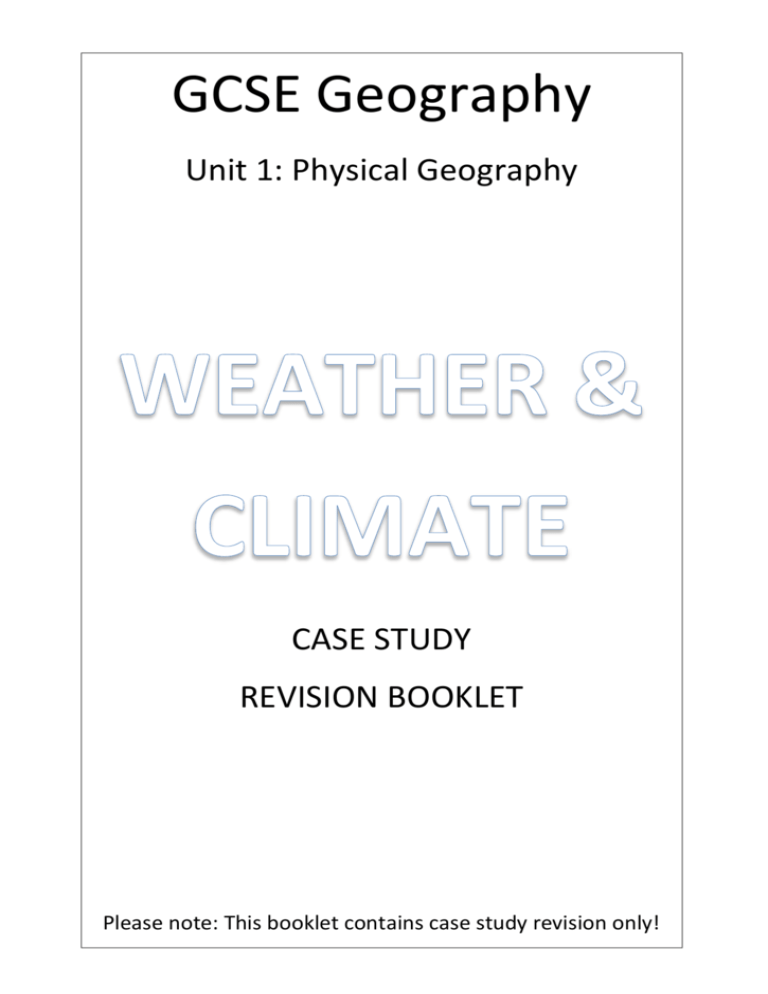
GCSE Geography Unit 1: Physical Geography CASE STUDY REVISION BOOKLET Please note: This booklet contains case study revision only! You should still use your topic cover sheet to see what other EXTREME WEATHER EVENTS IN THE UK Extreme weather events in the UK Description of weather event Date Location Europe suffered intense heat wave. UK’s highest recorded temperature 38.5°c. Heat wave began in June through to August. Tourism increased in the UK but 2045 died as a result 2003 Kent Boscastle in Cornwall was hit by a major flash flood. Noone was killed but it effected 1000 residents and tourists 2004 Boscastel, Cornwall The south of England had its driest period since the drought of 1976. Hosepipes and sprinklers were banned 2005 Southern England Several people killed and thousands made homeless due to major flooding. Particularly long the river Severn where crops were destroyed, livestock drown and major roads were impassable 2007 Major areas that suffered were Tewkesbury and parts of Gloucester Very wet summer, torrential rain fell on already saturated ground. Many areas flooded. 2008 Somerset, south Wales, Worcestershire and Northhumberland Devon A Torrential Hailstorm in Devon brought 100mm of rain and hail in a few hours January saw the BIG FREEZE hit the UK. Coldest winter since 1962-3, night time temperatures fell as low as-20°C. Gas supplies became under pressure because many people turned up their heating. Large companies had their gas supplies rationed so that homes could be heated. Supplies of rock salt used for roads became low and minor roads had to be left untreated. 2010 UK A CASE STUDY OF AN EXTREME WEATHER EVENT IN THE UK: SUMMER FLOODS OF 2007 Cause of the flooding • Movement of the jet stream further south blocking the high pressure system over Spain leaving an area of low pressure over the UK. A low pressure system is responsible for rainfall • Meeting of the cool and moist Atlantic air mass and warm dry airmass from Spain and France caused condensation and precipitation. 400mm fell in two months • Ground continuously saturated between May and July 2007 which lead to Increased run off • Large amount of water fell in the drainage basins of the River Severn and Thames where the land is flat which encouraged the water to spread laterally (sideways) Effects of the Summer 2007 Floods - Impact on people’s Homes and Lives - 49,000 homes flooded - 14 people died in floods ½ million people left with no electricity 350,000 people were without drinking water, including most of the population of Gloucester, Cheltenham, and Tewkesbury due to water treatment plants flooding One out of 3 people reported effects on family life and relationships e.g. worsebehaved children, young children afraid of the rain, strain of living in caravans) Average time spent out of their homes was 9 months Impact on Health - Sewage from drains mixed with flood water this created a health hazard to people and animals. - Two out of 3 people suffered from chest infections, stomach upsets, skin complaints etc - One out of 3 people suffered from mental health problems e.g. depression Impact on Agriculture - 50Km square of agricultural land was flooded. - Crops were damaged, especially broccoli, carrots, peas and potatoes. 40 % of pea crop lost. - Farm animal’s drowned. - Prices of broccoli, carrots pees and potatoes rose in shops. Impact on Transport - Railway networks flooded this led to a loss of business, cost of repair, disruption to transport. - £131 million cost to date to repair roads across the country. - Roads and bridges collapse in Ludlow Shropshire. - £17 million for roads and bridge repairs in Shropshire alone. Cost of the floods £3billion of damage across UK, Gloucestershire cost £37 million alone 130,000 insurance claims were made after the floods. - Benefits/Issues raised-need for adequate warning, preparation and plans to deal with the impacts The sense of community developed in Tewkesbury during the flood has continued to some extent Signed up 73000 more people have signed up to the Environment Agency’s free flood warning system There are now 34,000 new flood defences protecting 30,000 homes There were plans to spend another billion to protect 145,000 homes over the next few years CONSEQUENCES OF GLOBAL CLIMATE CHANGE ON THE UK Economic Major towns and cities in the UK will be flooded due to sea level rise. Example…(Liverpool, Edinburgh, Middlesborough, Kingston Upon Hull, London, Bristol, Preston, Carlisle, Great Yarmouth) Scottish ski resorts could be threatened with closure as snow becomes less common Low-lying Norfolk Broads, worth £5 million as a tourist destination, may become flooded. Sea levels could rise by 26-86cm by 2080 in the south-east, threatening low lying coastal cities such as London. Recently induced crops such as vines (grapes) and olives may prosper in southern England New crops such as oranges and peaches may be able to be grown in Southern Britain Intensive agriculture will be able to spread further north in Scotland Increased length of growing season promotes farming and increases food supply Accidents and disruption to transport will be less likely to occur in the winter, with less snow and ice on the roads Social Warm climate diseases such as Malaria may spread to the UK Heat-induced deaths may increase, particularly among the elderly Winter heating costs will go down People will holiday more in the UK, reducing the costs of family holidays. Environmental Artic plants in Scotland may face extinction Coastal erosion on soft-rock coastlines, such as north Norfolk will increase. Broadleaved trees could suffer in drought conditions, especially in Wales Increased demand for water in hotter summers will put added pressure on water supplies Coastal habitats such as salt marshes will become squeezed between the sea and coastal defences as sea levels rise Droughts and floods will become more likely as extreme weather events become more frequent. Conifer trees will thrive in wales and Scotland Accidents and disruption to transport will be less likely to occur in the winter, with less snow and ice on the roads Windier weather may provide additional power for wind farms Political Government is put under pressure to reduce greenhouse gas emissions Debate over the future of the UK’s energy sources. Worry that the cost of developing renewable energy sources could have a negative impact on the country’s economy. CONSEQUENCES OF GLOBAL CLIMATE CHANGE ON THE WORLD Economic Alpine ski resorts close down due to a lack of snow (French and Swiss alps) Drier conditions in Mongolia and Central China reduce grain harvest Increased costs due to the damage caused by more frequent and intense tropical storms in the Caribbean and USA Frozen regions of the world such as Siberia and Northern Canada may be able to grow crops in a milder climate Higher rainfall in Southern China increases crop yields Canada’s North-west Passage may become ice-free and can be used by shipping Energy consumption may go down as temperatures increase in north-west Europe Fewer deaths or injuries due to cold weather. Longer growing seasons in rich agricultural regions such as Europe and North America. Social Drier conditions in Africa will reduce cereal production and water supply leading to starvation and civil war. Tropical diseases in Africa are likely to spread northwards. An additional 280 million people may be at risk of malaria, particularly in China and central Asia Higher sea levels may flood low-lying areas such as Bangladesh, Myanmar and the Netherlands, threatening the lives of 80 million people Loss of glaciers (fresh water) in the Himalayas may threaten agriculture and water supply in India, Nepal and China. Increased frequency and magnitude of tropical storms in the Caribbean and USA increase therefore there is an increase threat to life and property Fewer deaths or injuries due to cold weather. Environmental Reduced rainfall in tropical rainforests in places like Brazil due to deforestation Floods in the Nile delta Flooding in the Netherlands Arctic ocean ice sheet could melt completely – already thinning by 40% Too warm for coniferous forests in Alaska and Northeast Russia Hazards such as landslides, floods and avalanches may become more common in mountainous areas such as the Alps. Some species who’s habitat changes, may become extinct, e.g. Polar Bear in the Artic Increased frequency and magnitude of tropical storms in the Caribbean and USA Pacific islands such as Tuvalu, Kiribati group and Marshal islands likely to disappear due to sea level rise Icebergs from break-up of Antarctic ice shelf could endanger shipping Political Increase conflict between countries and their pollution levels. Increased conflict of resources in countries where they are becoming scarce. E.g. water sources in India and Pakistan. Increased migration due to famine and drought to European countries. Conflict between tribes over land and scarce resources. Increased collaboration between countries to reduce the impact of global climate change Increased income gained for less developed countries selling their carbon credits RESPONSES TO THE THREAT OF GLOBAL CLIMATE CHANGE GAS SOURCE Burning Fossil Fuels CARBON DIOXIDE Deforestation INDIVIDUAL LOCAL NATIONAL INTERNATIONAL Conserve energy like turning off lights, putting things on stand by Grants offered to people to have loft and cavity insulation Look into alternative energy sources. UK investing in Offshore wind farms Kyoto agreement – countries signed up to reduce carbon emissions by 50% by 2050 Buy recycled paper Recycle paper in bins provided by local authority Urban forests in Wolverhampton. Allocation of Urban and country parks to protect woodlands Recycling campaigns Allocation of protected areas such as national parks and SSSI’s DEFRA – prosecute against illegal logging Organisations involved over many countries such as Oxfam and Friends of the Earth that campaign against rainforest destruction Reduce waste and recycle Wolverhampton has an incinerator to burn waste reducing landfill Different bins provided to increase recycling National initiative on waste reduction in UK The Global Methane Initiative (GMI) is a voluntary, multilateral partnership that aims to reduce global methane emissions and to advance the abatement, recovery and use of methane as a valuable clean energy source. Alternative food chosen To drown rice paddies to prevent methane escaping in certain areas Population reduction policies, few people = less food needed Walk and use public transport Travel wise – Wolverhampton initiative to encourage car sharing. Congestion charges e.g. London Increase parking fee’s Increase car and fuel tax to discourage the use of and buying of cars Kyoto agreement – reduction of car emissions Sharing technological advances buying hybrid cars and electric cars Buy organic food Promote and advertise organic food Allocating nitrogen sensitive zones that ban the use of fertilisers in areas close to water sources Money supplements offered to farmers to encourage them to use Organic farming methods that are more expensive. International Nitrogen Initiative Aim to encourage the production of sustainable food production and minimize nitrogen’s negative effects on human health and the environment resulting from food and energy producti Landfill Sites METHANE Rice farming Car exhaust NITROUS OXIDE fertilisers TROPICAL CYCLONE CASE STUDIES: ONE FROM A RICH PART OF THE WORLD (Katrina) AND ONE FROM A POOR (Nargis) IMPACT AND RESPONSES KATRINA 2005 NARGIS 2008 Formed over the Bahamas Winds 280kph 3 – 8m storm surge 200mm rainfall Levees failed resulting is widespread flooding New Orleans already below sea level in places Made landfall New Orleans Formed in bay of Bengal Winds 215kmp 3.5m storm surge Irrawaddy region badly affected by the storm surge Irrawaddy delta is just about 1m above sea level SOCIAL EFFECTS 1,836 confirmed dead 100’s of 1000’s displaced or evacuated 3 million without electricity High insurance premiums that people cannot afford ECONOMIC EFFECTS $89 billion 30 Oil platforms damaged, reduced production by 25% Increased world petrol prices At least 140,000 dead 2-3 million homeless In Irrawaddy 95% of homes destroyed 1.5 million people affected Diarrhoea, dysentery and skin infections afflicted some survivors crammed into public houses such as schools $10 billion 60 per cent of farming implements were lost ENVIRONMENTAL EFFECTS Flood waters severely polluted Mississippi delta physically changed by erosion (change of shape) Coastal habitats lost or damaged Breeding grounds for turtles and migrating birds lost 80% of New Orleans flooded nearly 25m litres of oil were pumped into Lake Pontchartrain TROPICAL CYCLONE DETAILS Saltwater from storm surge damaged farmland and water sources Burst sewage pipes caused pollution IMPACT AND RESPONSES KATRINA 2005 NARGIS 2008 Charities raised over US$4.25 billion from voluntary contributions. Help arrived within a few hours. Coastguard rescued over 33,500 people, 58,000 troops sent Refrigerated trucks for dead bodies Rescuing people, treated injured, provided food, water and shelter FEMA paid temporary hotel costs for families Burma (now Myanmar) refused to allow ships from France and the US to enter Burmese ports The government refused aid and relief for several weeks LONG TERM RESPONSES Rebuilding New Orleans July 2006 there were still about 100,000 people living in 37,745 FEMA-provided trailers Strengthening of the levees Some evacuees have not returned Rebuilding homes and workplaces $1 billion was needed to cover the most urgent needs (food, agriculture and housing) for the next three years. Methods to reduce salt content from farmland Rebuilding services and transport networks MONITORING AND PREDICTION Was monitored and predicted accurately People had no idea the cyclone was approaching PREPARATION 80% of people evacuated No-one was evacuated PROTECTION Public transport closed down. Levees should have protected the area from flooding No protection from storm surge or flood waters. SHORT TERM REPONSES Indentified and buried the dead Treated the injured Provided safe water, food and medicine


